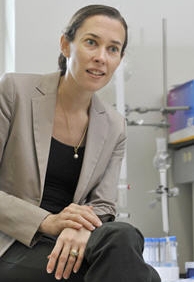Biomedical engineers from Johns Hopkins University in Baltimore have devised a method for growing cells to repair cartilage damage from injury or age. The team led by Jennifer Elisseeff (pictured right) reported its findings last month in an online issue of the Proceedings of the National Academy of Sciences; paid subscription required.
Cartilage is one type of tissue that does not repair itself. Elisseeff’s lab has been studying the cartilage environment, a three-dimensional mix of protein fibers and gel that provides support to connective tissue throughout the body. The team has focused on cartilage cells called chondrocytes, and developing a form of scaffold that supports the complex structure of cartilage, while searching for cues for new tissue cells to grow and differentiate.
In the lab, the Hopkins team created a network of nanofibers with a process that sends a polymer stream onto a charged platform, and added chondroitin sulfate, a compound found in joint supplements, to encourage growth. The researchers used these fibers to build and test several types of scaffolds, using derived stem cells from goat bone marrow to use as a medium in the lab to test the way scaffolds helped grow new tissue. They found a larger volume of cells could be produced with the scaffold than without.
Elisseeff and colleagues then tested their method on rats. They implanted the nanofiber scaffolds into damaged cartilage in the knees of rats, and compared the results to damaged cartilage in knees left alone, as measured by the production of collagen, a fibrous connective tissue found in cartilage. The researchers found that the limbs with damaged cartilage treated with nanofiber scaffolds generated a higher percentage of a more durable collagen than those damaged areas that were left untreated. The more durable collagen, known as type 2, is usually lacking in surgically repaired cartilage tissue.
While the technology is still years away from human implants, Elisseeff believes the team’s discoveries are an important advance in finding an effective treatment for joint pain. “Rather than just patching the problem with short-term fixes, like surgical procedures such as microfracture,” says Elisseeff, “we’re building a temporary template that mimics the cartilage cell’s natural environment, and taking advantage of nature’s signals to biologically repair cartilage damage.”
Read more:
- Physical Properties of Productive Stem Cells Identified
- Study: 4.5 Million Americans Had Knee Replacement Surgery
- Stem Cell Bandage Approved for Clinical Trial
* * *


 RSS - Posts
RSS - Posts
You must be logged in to post a comment.